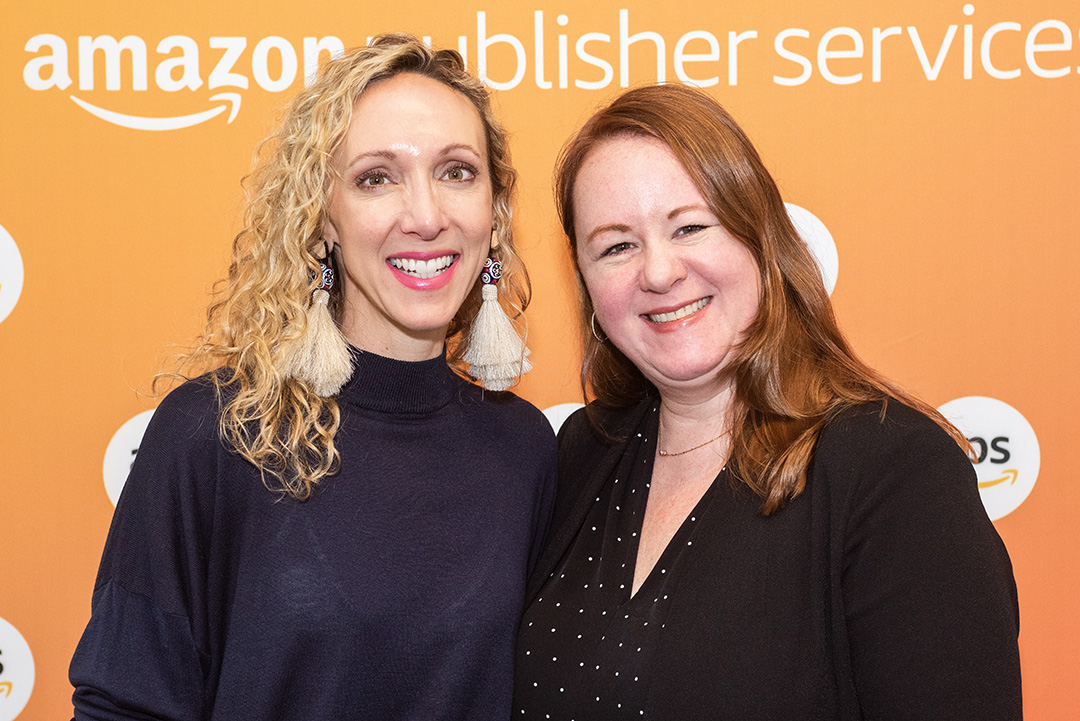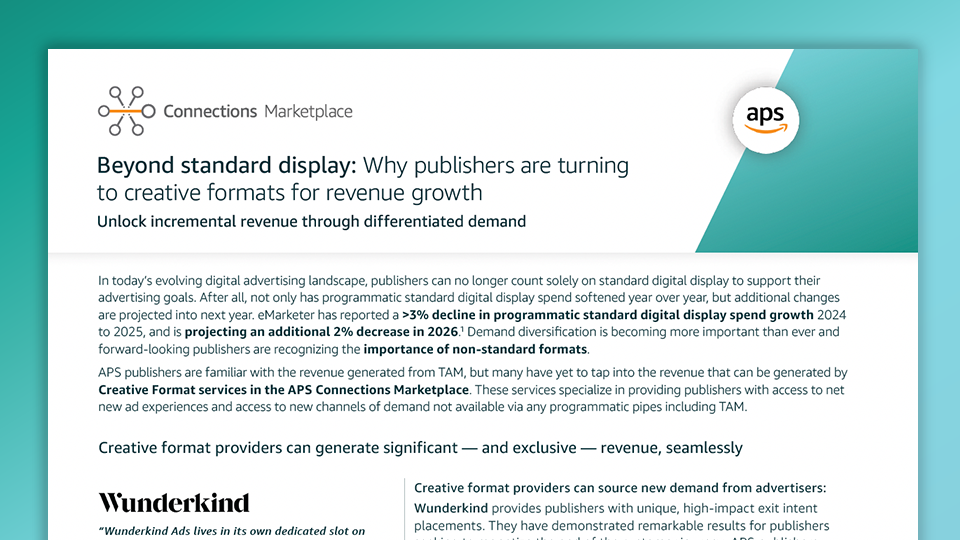June 1, 2023
- Publishers are focusing on customers, going back to basics, prioritizing great content for users with the right kinds of ads for their audience, and reminding fellow publishers to be patient and always finding the opportunities in the challenges presented.
- The advice for publishers from Amazon’s Neal Richter, is that it’s all about signals. Higher signal density in the bid stream can drive up yield; understand the signals you and your partners are passing, and, whenever possible, analyze your inventory from a demand side perspective.
We held our first Amazon Publisher Services (APS) Publisher Summit in New York City on May 2, 2023. We hosted a small subset of customers, and held three speaking sessions inside one of the Amazon offices.
Publisher panel discussion
The first session was a Publisher Panel discussion moderated by Scott Siegler, Director of Demand and Services at APS and included a diverse group of speakers from various publisher formats including Sara Badler, CRO, Programmatic Advertising & Partnerships at Dotdash Meredith; Huda Kazi Vice President, Ad Technology & Operations at Warner Bros. Discovery; Amanda Dean, Head of Programmatic Partners at The Weather Company, an IBM Business; and Brian Kaminsky, Chief Data Officer and President of Revenue Strategies at iHeartMedia.
The group discussed how they’re addressing macroeconomic headwinds and shared some interesting things their organization is doing.
“One of the things that we’re examining right now is, who are our most dedicated customers. We’re looking at which customers are renewing, which customers are spending the most money with us at scale, not just the biggest customers, but across the continuum from tier to tier, and making sure that we’re coming to them first, with our insights, with opportunities to leverage technology to learn from, etc. We want to make sure that we’re over servicing those customers who are committed to our product, because it’s much more affordable to renew, and to satisfy and expand a commitment from a customer than it is the prospect that you want. That’s not to say we’re not prospecting. But we’re always trying to provide a higher level of service, given the tough economic times, given the change in consumer behavior, to make sure that folks that have been with us are going to benefit from that and continue to think of us first as a regular part of their marketing spend,” Brian Kaminsky, Chief Data Officer and President of Revenue Strategies at iHeartMedia shared.
When it comes to key metrics and what’s most important, Amanda Dean, Head of Programmatic Partners at The Weather Company, an IBM Business added, “At the end of the day, buyers want engagement, and they want time spent, and they reward you with spend when they find their audiences interacting and engaging with you. So, we’re looking at going back to basics and expanding our content footprint. Soon you’ll begin to see a new reimagining of weather on a couple of platforms.”
Huda Kazi Vice President, Ad Technology & Operations at Warner Bros. Discovery added, “I think for us in the streaming TV business, we’re looking at how do we drive the ROI for the buyer, but then also provide a delightful experience for the customer. Nobody needs to see the same ad over and over and over again or poor-quality advertising. We want to help the buyers find the people that they’re looking for and find audiences that are actually going to invest in the products that they are pitching. So, we’re going to be leaning into data and understanding what exactly is the ROI that we are driving for our advertising customers? But also, how do we find that balance between the user experience and the revenue? Because yes, we want the revenue. But without customers that watch our content service, we won’t actually have it. So, it is a delicate dance. It’s a balance. We’re continuing to refine it. But it’s really important to be able to remember that we have two sets of clients, the people who actually consume the content, and the people who are purchasing advertising platforms.”
Going back to basics and focusing on what matters seemed to be a theme across the panel. “You always want to drive incrementality. That’s the goal for all of us and it’s about understanding how to do that. Each business is so different and we have so many different businesses. Just because it means it’s going to work for one doesn’t necessarily mean it’s going to work for the other. So, we also have to think a little bit more and be strategic about how we’re doing that. I think one thing which is interesting, because it wasn’t said often a few years ago, but it’s the user experience. We ask ourselves, how do we make the experience really great for the user so that they are actually getting out what they want or what they came for,” added Sara Badler, CRO, Programmatic Advertising & Partnerships at Dotdash Meredith.

Image from left to right: Sara Badler, CRO, Programmatic Advertising & Partnerships at Dotdash Meredith; Brian Kaminsky, Chief Data Officer and President of Revenue Strategies at iHeartMedia; Amanda Dean, Head of Programmatic Partners at The Weather Company, an IBM Business; Huda Kazi Vice President, Ad Technology & Operations at Warner Bros. Discovery (Photo Credit: Lemonlight)
Fireside chat with Kari Callahan
The second speaking session was a fireside chat between Meredith Goldman, Director of Amazon Publisher Direct and Kari Callahan, Director of Global Media and MODE at Amazon.
For publishers, a big question on their mind was how to best position their inventory to increase visibility or value to XCM for activation. “Honestly, double down on Amazon Publisher Services,” Kari Callahan said. “One of the things we always start with first is really understanding the audience, who we are looking to reach, what their engagement with Amazon is today, and where are the greatest opportunities for growth. Then we look at it from the channel perspective, understanding our audience’s media consumption habits, what channels they consume, the interactions between those channels, past efficiencies that we’ve seen with those channels. Then one of the first calls we make is to our partners within the organization to understand how much of this can we actually address through our Amazon DSP. Because of the audience signals we have and some of the measurements on the backend, it still tends to be our most efficient channels. So, we’ll start with Amazon DSP and then we build out with other partners from there.”
And in looking to the future, Callahan added, “when it comes to formats in the market, a lot of our plans will have a mix of video and audio and display, and a variety of different kind of formats, but how we utilize them, really is the art and science of media today. One of the challenges that I think we all face right now is having that holistic view of the customer experience. Where we can come together as an industry in regards to how we look at our audiences, the customer experiences, and really getting an understanding, not just of the who, but also the how your customers are engaging with your content across touchpoints.”

Image from left to right: Meredith Goldman, Director of Amazon Publisher Direct and Kari Callahan, Director of Global Media and MODE at Amazon (Photo Credit: Lemonlight)
Presentation by Neal Richter
The final presentation was from Neal Richter, Director of Bidding, Analytics and Engineering at Amazon.
When asked what advice he has to make inventory more valuable in general, Richter shared, “I always start with, it’s about signals. Understanding, what is the set of signals your supply path and your supply partner are passing on your behalf? Is your inventory known in ads.txt, and are you in the sellers.json spec? Are you passing things like SDA (Seller Defined Audiences) or other differentiated insights? How does your index of viewability look? If you were to benchmark your site, by advertiser vertical, do you perform eCPA (effective cost per acquisition) basis? Do you have render problems? Render rate of ads is a good one, just a suite of KPIs (key performance indicators). I think the other one that I’ve recommended a lot is, log into a DSP (demand-side platform) and see what your inventory looks like. Look at the deal catalog. See how you show up and how your inventory and your placements are represented in a not-so-great DSP, it’ll look like anonymous holes for ads to go on particular websites. I also recommend to prioritize PMPs (Private Marketplaces) that convey priority to the buyer as well as better pricing and open market, or if inventory is scarce, it may provide better pricing. So, package it well. Notice how that inventory performs from an advertiser.”
Learn more about APS at aps.amazon.com

Image: Neal Richter, Director of Bidding, Analytics and Engineering, Amazon (Photo Credit: Lemonlight)


